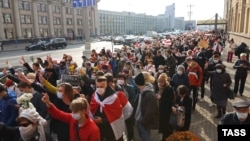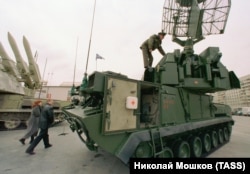Belarusian protesters are not the only ones watching how labor strikes in Belarus develop: Russia, the Eastern European country’s closest ally, has billions of dollars in loans and some key military supplies and energy deliveries linked to Belarus’ economy as well.
The walkouts began on October 26 after Alyaksandr Lukashenka ignored former presidential candidate Svyatlana Tsikhanouskaya’s demand for his resignation after an August 9 presidential election dismissed by the opposition and much of the international community as fraudulent. Hundreds of people, including strikers, were detained the first day of the strike.
Citing the convergence between the two countries’ economies, Russian presidential spokesman Dmitry Peskov underlined on October 26 that Moscow is attentively “following” the situation.
“For us, it’s extremely important how rhythmically and securely these companies of Belarus are functioning,” said Peskov.
Aside from the Kremlin’s wariness of massive protest movements, Russia has a strong financial motive to keep an eye on that dynamic: Russia holds or controls 60 percent, or over $10 billion, of Belarus’ external state debt, according to the Institute of International Finance, The Moscow Times reported this September.
That month, Russian President Vladimir Putin agreed to loan an additional $1.5 billion to Belarus by 2021 to stave off the economic effects of the COVID-19 pandemic and to ease a credit crunch.
Although outside analysts have described this latest loan as more of a refinancing of outstanding debt -- $330 million out of the initial $500 million would cover Belarus’ debt to Russian energy giant Gazprom – it is an amount that Russia, suffering its own COVID-19 economic slowdown, is not granting for free.
The initial $500 million appears to carry a roughly 4.75-percent interest rate; payback begins after a five-year grace period. An interstate loan of $500 million will make up the rest of this year’s payment, but the measure requires that the Russian parliament first adopt amendments to the Budget Code, which regulates Russia’s state expenditures, Russian Finance Minister Anton Siluanov told the state-run Rossia-1 television channel. The remaining $500 million would be paid as another interstate loan in 2021.
Siluanov, however, expressed no concern about Belarus’ creditworthiness. “We think that it is a very good borrower," BelTA reported him as saying on September 21.
Yet if a national strike truly takes hold and affects the Belarusian economy, that could conceivably take a toll on Belarus’ ability to pay interest on any external debt. The World Bank already had estimated that the coronavirus pandemic alone could cause Belarus’ economy to contract by 4 percent this year.
Russian banks with offices in Belarus already have been asked to assist Belarusian banks experiencing cash flow problems. Withdrawals of bank deposits and conversions of Belarusian rubles into dollars continue, said Tsikhanouskaya economic advisor Ales Alekhnovich.
Amidst the ongoing uncertainty, both the dollar (2.63 Belarusian rubles) and euro (3.07 Belarusian rubles) gained slightly against the Belarusian ruble on October 29, while the Russian ruble (.03 Belarusian rubles) lost some value.
Yet, despite opposition assurances of a nationwide work stoppage, little suggests that the strikes are akin to the Solidarity demonstrations in neighboring Poland in the early 1980s that led, eventually, to the 1989 electoral defeat of its communist government.
An online map of the strikes assembled by the civil-society movement Chestnye Lyudi (Honest People) reported 5,620 striking workers at 367 companies, as of October 29. Chestnye Lyudi supports the strikers with legal, financial, and planning assistance.
Some of Belarus’ largest firms -- the state-run Belarusian Railway, fertilizer manufacturer Grodno Azot, the Minsk Tractor Works, the Minsk Electromechanical Factory, and private home- appliances manufacturer ATLANT – are among “an entire series” of factories taking part, noted Paval Latushka, one of the leaders of the opposition’s Coordination Council.
The fact that strikes have occurred at companies with higher salaries ($800-$1,000 per month), such as the state-owned Minsk Automobile Plant and privately owned potash-mineral-fertilizer producer Belaruskali, “clearly testifies to the fact that the protest is not social, but political,” Alyaksandr Yaroshuk, chairman of the Belarusian Congress of Democratic Trade Unions, commented to the Russian daily Novaya Gazeta.
Some of these firms feature prominently in Belarus’ exports to Russia. Though dairy products and meat account for the bulk of that trade, in 2019, trucks, tractors, and spare parts for cars and tractors accounted for over 10 percent of its nearly $13.6 billion in exports, according to official data.
While Russian dairy and meat producers likely would welcome a slowdown in shipments of heavily subsidized Belarusian products into Russia, commented the Russian business newspaper Vzglyad (View) this August, the tolerance for any potential slowdown in Russian gas exports to Belarus is less robust. With European markets already at capacity, Russia would be left with 14-16 billion cubic meters of gas and no market if Belarus halts its discounted purchases, commented Igor Yushkov, an expert at the National Energy Security Fund, a Russian think-tank.
At least some workers from Belarus’ two oil refineries, Naftan and Mozyr, also reportedly have joined the strikes. The two refineries both supply diesel fuel and other oil products to Russia via Belorusneft, Belarus' main petroleum exporter. Plans had existed for Belarus to increase those exports to 50,000 tons per month, the firm announced early this month.
Moscow’s concerns likely also extend to the defense sector. Belarusian companies account for 15 percent of the Russian government’s military orders, supplying equipment that is “unique” and “irreplaceable,” military columnist Aleksandr Khrolenko wrote in the Russian state-run Sputnik news service this August.
Strikes or walkouts of varying scale reportedly have now occurred at some of these suppliers, too.
MZKT, for instance, not only produces heavy-duty trucks, but also the chassis for Russia’s Topol-M and Yars Intercontinental Ballistic Missile systems as well as its short and medium-range Tor and Tunguska anti-aircraft missile systems.
Semi-conductor manufacturer Integral delivers microcircuits for Russian missiles; optoelectronic company Peleng produces fire-control systems, while optics manufacturer BelOMO dispatches equipment for “high-precision measurements” by “airborne apparatuses,” noted Khrolenko.
The exact size of the walkouts or work stoppages at these companies is not entirely clear.
At fertilizer manufacturer Hrodna Azot, another Russian exporter, the head of the strike committee conceded on October 28 that the number of company workers actively striking is relatively small: Only 17 people out of a workforce of 10,000 have “openly” joined the strike committee, Yury Rodovoy told Current Time.
“You think that that’s not very many, but these are the people who have openly expressed their position,” said Rodovoy. “Many people just don’t come [to work], don’t pick up the phone, and stay at home. Many are on sick leave …”
“It’s difficult for me to say what the concrete number of people is, but it’s close to a hundred, he estimated.
Hrodna Azot General Director Igor Bobyr, however, underlined on October 29 that the company is working as usual. Bobyr attributed any absences to sick leave for COVID-19.
Not all of the companies with walkouts or strikes are strategic, industrial concerns, though. Cafes, restaurants, and retail stores make up the number as well. Students and teachers at some of the country’s state-run universities have also joined in – a trend that Russia attempted to discourage during its own 2019 protests over candidate registrations for local elections.
Despite its scrutiny of Belarus, the Kremlin, though, claims that it has no interest in interfering in its ally's strikes and protests. “We don’t get into these questions,” Russian President Putin stated on October 29.
The Belarusian government, however, expresses no alarm about any work stoppages. In October 29 remarks to officials, Lukashenka, who has alleged without proof that Poland and Lithuania are paying the strikers, stressed that companies “must kick out into the street” individuals “who don’t want [to work],” but “want to stage rallies.”
“It will be easier for us to sort them out in the street,” the official news agency BelTA reported Lukashenka as saying.
Given its own 2019 protest crackdowns, Russia likely would agree.
-With additional reporting by BelTA, Interfax, Reuters, Sputnik, and TASS











Facebook Forum